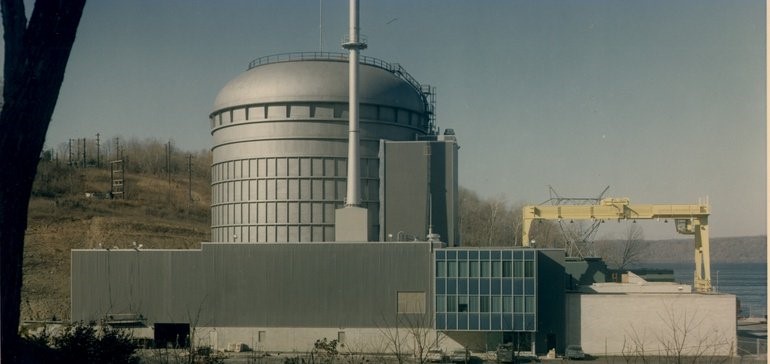October 2023
Listen Now
Issue
-
Dispatchable (available on demand) electric generation capacity is needed due to the intermittent availability of generation by renewables like wind and solar. Only fossil fuel and nuclear plants can provide dispatchable power and only nuclear plants produce zero emissions.
-
New large Nuclear Power plants are very costly to construct and represent a major challenge for utilities to finance.
-
The management of used nuclear fuel is problematic, but the near- to medium-term solution is to store the used fuel at the operating plant sites.
-
Proven safe operation of adequately designed nuclear plants is a prerequisite for the social license to construct new nuclear power plants.
Background
Nuclear power currently produces almost 20% of the electricity in the U.S., [19.7% in March 2023] with 93 [June 2023] operational nuclear power reactor plants located in 27 states [in 2023]. Although there are plans for as many as 23 new reactors, only one will come online by 2025. Since about 2010 low natural gas prices have dampened plans for new nuclear capacity.
Nuclear energy is an important element in the U.S. electric generation portfolio and represents the largest producer of nearly emission-free electricity. Most U.S. reactors already have seen their licenses extended to 60 years from 40 years. Many nuclear plant operators will attempt to increase extended operation out to 80 years.
New smaller, modular reactors are under design to provide less expensive, expandable generation options.

Fig. 1 Exelon's Peach Bottom Becomes 2nd Plant to Receive Life Extension to 80 Years
There is a need to maintain the dispatchable generation capability provided by nuclear, natural gas and coal plants.1,2 These are the plants that provide electricity around the clock. They are needed to provide reliability and resiliency to the electric grid. They are particularly important during severe weather events when renewable sources are unavailable.2 Renewable sources of electric generation are non-dispatchable due to the intermittent nature of their availability to meet demand.
New generating equipment has escalated in price due to the demand for commodities such as concrete, structural steel and copper for China and India. Nuclear plants are among the most capital intensive of electric generating stations. However, nuclear fuel costs are very low.
What is important in the long run is the cost of electricity produced by the various forms of generation. The estimated levelized cost of electricity for all forms of new generation for deployment in 2027 has been reported by the U.S. Energy Information Administration. See table below:
| Plant Type | Estimated Levelized CostA of Electricity Generation for New Generation Resources Entering Service in 2025 (2019 dollars per megawatt-hour)B |
|---|---|
| Dispatchable Technologies (Available On Demand) | |
| Ultra-Supercritical Coal | $82.61 |
| Combined Cycle Gas | $37.94 |
| Combustion Turbine Gas | $117.86 |
| Advanced Nuclear C,D | $81.71 |
| Geothermal C | $37.62 |
| Biomass | $90.17 |
| Non-Dispatchable Technologies (Intermittent Availability) | |
| Onshore Wind | $40.23 |
| Offshore Wind | $105.38 |
| Solar Photovoltaic C | $33.83 |
| Solar Hybrid C | $49.03 |
| Hydroelectric | $64.27 |
A The Levelized Cost of electricity generation is an estimate of the revenue required to build and operate a generator over a 30-year cost recovery period.
B The estimated cost of electricity does not include any CO2 charges.
C The cost for these technologies includes a tax credit.
D The levelized cost of nuclear generation does not consider the added revenues generated beyond 30 years for plants which typically operate for as long as 60 to 80 years.
Reference: Levelized Cost and Levelized Avoided Cost of New Generation Resources in the Annual Energy Outlook 2022 (Table 1b), U.S. Energy Information Administration, February 2022.
SME Statement of Technical Position
SME supports the continuing research and development of nuclear power in four principal areas. These include Research & Development to support:
-
The safe and economic operation of the current fleet of nuclear plants for operation over 60 years. The Department of Energy (DOE) has a program called the Light Water Sustainability Program to help fund this R&D in collaboration with industry.
-
The development of small, light water, modular reactors for deployment in the next decade. These reactors utilize much of the technology used in the operating reactors. DOE has a program called Small Modular Reactors to support the design and licensing effort.
-
The development and demonstration of Advanced Reactors6 such as high-temperature gas-cooled reactors to provide process heat to refineries and chemical and fertilizer production facilities. DOE has a program called the Next Generation Nuclear Plant which is part of a public-private partnership.
-
The development and demonstration of used nuclear fuel recycling techniques that do not pose a nuclear proliferation threat to help manage the high-level wastes. Recycling of the fuel provides for greater resource utilization and reduced burden on deep, geological repositories.7 DOE has a program called the Advanced Fuel Cycle Initiative to provide proven recycling technologies in the post 2020 timeframe.
